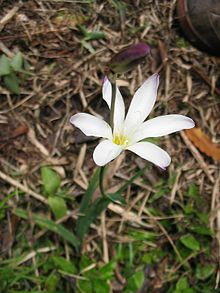Sparaxis
| Sparaxis | ||||||||||||
|---|---|---|---|---|---|---|---|---|---|---|---|---|

Tricolor fringed sword ( Sparaxis tricolor ) |
||||||||||||
| Systematics | ||||||||||||
|
||||||||||||
| Scientific name | ||||||||||||
| Sparaxis | ||||||||||||
| Ker Gawl. |
Sparaxis is a plant kind from the family of the Iridaceae (Iridaceae). It comprises 15 species that are found exclusively in South Africa.
description
Sparaxis are perennial, herbaceous plants . They grow from small, round tubers that are rooted at the base; the tubers are protected by a fine to hard, fibrous cover. The bald stem is firm, thick and almost upright, either unbranched or branching at the base or just above it, then in its lower armpits there are occasionally large or numerous small daughter tubers in all armpits. The leaves are mostly at the base, and the stem is rarely leafed. The lowest two to three leaves are sheath-like, membranous lower leaves , the other leaves are lanceolate to linear or sickle-shaped, glabrous and with a protruding central rib and numerous fine, closely spaced side ribs.
The inflorescence consists of a few to several (rarely single) flowers in a loose spike , as distich buds , almost spiral-shaped at the time of flowering. The bracts are dry-skinned and wrinkled, pale and with brown stripes, simply to slightly slit or deeply slit.
The flowers are actinomorphic or zygomorphic , in the latter case either only the stamens are arranged asymmetrically or the perianth , then the upper bract is enlarged and often dome-shaped and the lower three bracts are the smallest. The bracts are lanceolate to inverted ovate or spatulate and pointed or blunt at the end. The flower tube is either funnel-shaped, rather cylindrical at the base and widening towards the top or extended far beyond the bracts and dimorphic , cylindrical in the lower part, then abruptly angled and then widening.
The stamens are attached to the base of the throat, i.e. the enlarged flower tube, and are arranged either symmetrically or asymmetrically. The filaments are filiform, straight and surround the stylus , or bent outwards, or all three filaments are arranged opposite to the enlarged Blütenhüllblatt. The anthers are straight, curved or spiral-shaped and approximately attached to the base. The ovary is egg-shaped, threadlike the pen, straight and upright or unilaterally. The capsule is barrel-shaped to oblong and round and gives an idea of the outlines of the seeds through its firm outer skin. There are 4 to 15 round, relatively large and shiny seeds with a smooth surface per compartment.
The basic chromosome number is x = 10.
distribution
The genus is found exclusively in South Africa in the southwestern Cape region, the southern Namaqualand and the west of the Karoo .


Systematics
The genus consists of thirteen species and is divided into two sections , which differ essentially in that the species of the Sparaxis section have actinomorphic flowers and those of the Synnotia section have zygomorphic flowers. The Synnotia section was described as a separate genus in 1826, but Peter Goldblatt placed it in Sparaxis in 1991 .
- Sparaxis section
- Nodular fringed swords ( Sparaxis bulbifera (L.) Ker Gawl. )
- Sparaxis elegans (Sweet) gold leaf
- Sparaxis fragrans (Jacq.) Ker Gawl.
-
Large-flowered fringed sword ( Sparaxis grandiflora (F. Delaroche) Ker Gawl. ). With four subspecies:
- Sparaxis grandiflora subsp. acutiloba gold leaf
- Sparaxis grandiflora subsp. fimbriata (Lam.) Goldblatt (Syn .: Ixia fimbriata Lam. )
- Sparaxis grandiflora subsp. grandiflora
- Sparaxis grandiflora subsp. violacea (Eckl.) Goldblatt (Syn .: Sparaxis violacea Eckl. )
- Sparaxis maculosa gold leaf
- Sparaxis pillansii L. Bolus
- Tri-colored fringed sword ( Sparaxis tricolor (Schneev.) Ker Gawl. )
- Section Synnotia (Sweet) Goldblatt
- Sparaxis caryophyllacea gold leaf
- Sparaxis galeata Ker Gawl.
- Sparaxis parviflora (GJ Lewis) gold leaf
- Sparaxis roxburghii (Baker) gold leaf
- Sparaxis variegata (Sweet) gold leaf
- Sparaxis villosa (Burm. F.) Gold leaf
Further species of the genus - without assignment to a section - are:
- Sparaxis auriculata Goldblatt & JCManning
- Sparaxis metelerkampiae (L.Bolus) Goldblatt & JCManning
literature
- Peter Goldblatt: Review and Phylogenetic Analysis of Sparaxis. In: Annals of the Missouri Botanical Garden 79, pp. 143-159, 1992
Individual evidence
- ↑ a b Rafaël Govaerts (Ed.): Sparaxis. In: World Checklist of Selected Plant Families (WCSP) - The Board of Trustees of the Royal Botanic Gardens, Kew . Retrieved July 24, 2018.

